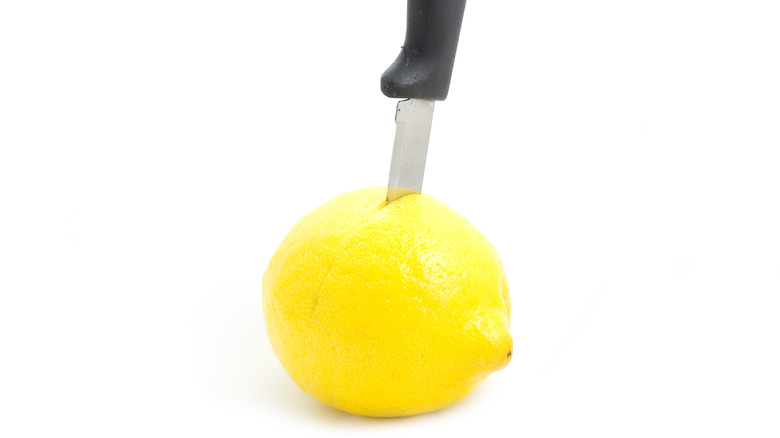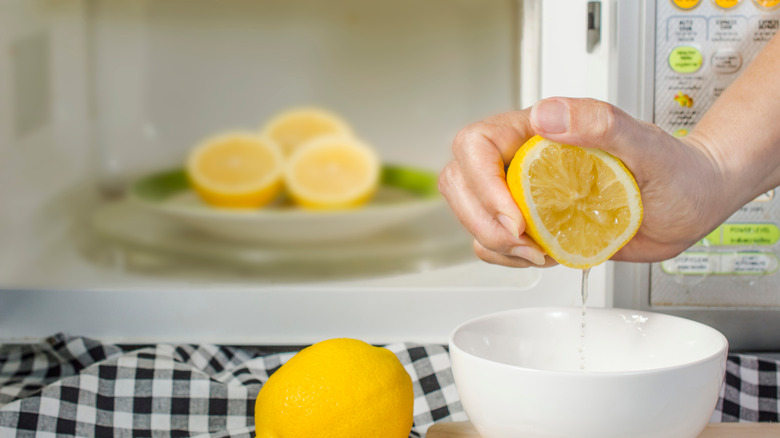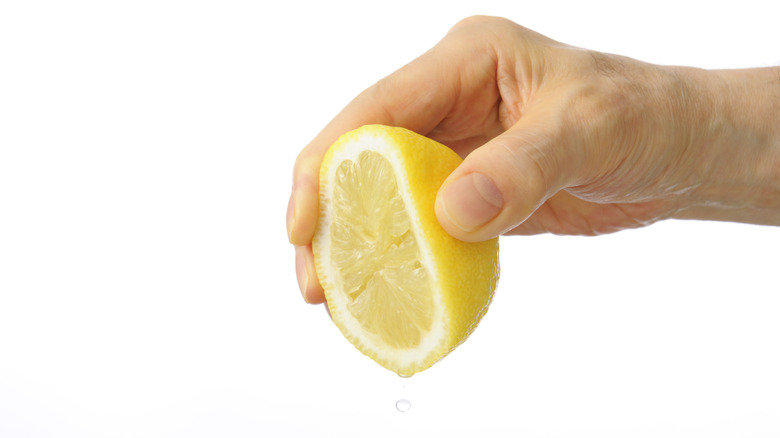Why You Should Always Stab Your Lemon Before You Juice It
Lemons are a refrigerator staple we should seldom leave the grocery store without; the versatile fruit is used in much of our cuisine. Often, it's the secret ingredient a dish needs to take it up a notch. While the bottled stuff is good in a pinch, its flavor is more tame than freshly squeezed juice and can't compare to the real thing in dishes needing a pronounced, bright citrus pop. Hovering around $2 per pound in the United States, the average lemon yields up to 3 tablespoons of juice. However, its ripeness and size are significant factors that determine if you'll get your money's worth.
Although there are cues shoppers should look for when purchasing the fruit, there are also techniques we can use at home to maximize the amount of lemon juice a single fruit yields. It may seem aggressive — and not a task for the kids — but stabbing the lemon repeatedly with a paring knife can help get every last drop from the citrus. When you pierce the peel before cutting the fruit in half, you have increased the number of areas from which the juice can be extracted. Instead of draining only from the cut side, the lemon juice can escape from all the little holes you made in the skin. However, if you're accident-prone or this hack reminds you too much of Dexter's kill room, there are more civilized ways to coax out the juice, too.
Other ways to get more juice out of lemons
Lemon juice is stored in the flesh's membranes. Aside from stabbing it, there are a few other methods to break down the flesh's fibers and get the most juice from the fruit. Whether using a juice press, reamer, or your hand, a firm lemon directly from the refrigerator can be difficult to squeeze. To soften a hard lemon, roll the whole fruit firmly with your palm on the countertop or give it a few whacks with a rolling pin to break down the membranes.
Although this takes some planning, freezing the whole lemon causes the fruit to expand, fracturing the fruit's cell walls. As it defrosts, the lemon softens and becomes more pliable. Lemons are more manageable at room temperature and can benefit from 20 seconds in the microwave or 30 seconds if the fruit is frozen.
When cutting, slice the lemon lengthwise from tip to tip rather than across the equator to get more juice. Fork tines work as well as a citrus reamer to puncture the membranes and coax out more juice from each half. Twist the fork into the flesh as you squeeze the lemon with your other hand. And, unless you use a juice press, it's a good idea to juice over a fine mesh strainer to catch the seeds and pulp.
How to pick the best lemons
Since we don't peel and eat the flesh of a lemon, we may be missing some cues indicating the fruit is at its peak before purchasing. Although citrus is found year-round in grocery stores, fall and winter is the peak season for most varieties. Aside from sweet Meyer lemons, a hybrid of a traditional lemon and mandarin orange, lemons are sour and won't get sweeter as they ripen. However, a lemon at its peak will yield more juice, so here's how to spot them.
Like other citrus, pick a lemon that seems heavy for its size. Pick up two to compare the differences in weight. Heavier-feeling lemons have more juice and less pith, the bitter white layer we don't use. The fruit should give a little when squeezed but shouldn't be squishy, indicating it is past its prime. If you have to, it's better to grab a firm lemon and wait for it to soften than purchase one already too soft.
The skin of a lemon should be smooth and bright yellow. Avoid fruits with wrinkled skin, signs of mold, or bruising. Growers often coat the fruit in wax to preserve it. The additive can be made of polyethylene, beeswax, or shellac, so if you plan to use the zest, opt for organic lemons. Either way, scrub, wash, and dry them before using.



